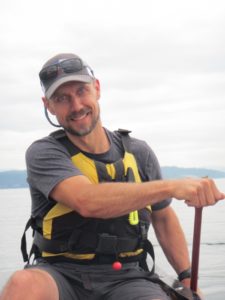Camosun Sports Management instructor Nevin Harper recently returned from a two-week trip to Bolivia with 10 Camosun students from a variety of different programs. Harper took his students everywhere from 4,000 metres above sea level—an altitude that can be dangerous if you’re not properly equipped—to the Sendra Verde ecological reserve, which is home to more than 700 animals.
“It’s truly experiential learning,” says Harper. “It’s well tied-in with the curriculum, and, yes, they need the learning outcome of those courses, but there’s a massive value added. The experience itself is really setting them on course for post-post-secondary in terms of a taste of the real world.”
In Bolivia there are cars driving in all directions on the road, a lack of governance, and a level of poverty unimaginable to many Canadians.
“They have access to less than five litres of fresh drinking water a day per person, whereas we’ve got about 300,” says Harper, adding that it is still one of the most peaceful cultures he’s observed.
But the real reason Harper chose Bolivia for the field school, which is run through Camosun International, is that it is “a place of extreme environments.”

“You get off the plane, you’re at 4,100 metres. That’s the highest airport in the world. Literally, it rocks your world. There are hand rails and oxygen tents in the airport.”
It was trip of extremes for Harper and his group of students. He says that there are many dramatic changes in terms of what students see and experience.
“The altitude, for me, is one of those things, especially for the students who are studying sport,” he says. “They have no control over that. They can’t outrun it. They actually have to become a little more aware and mindful of how many steps they take, and how fast they go up the stairs when they’re carrying their backpack.”
Harper says various measures were taken twice daily to combat altitude sickness, a form of oxygen deprivation.
“They actually are monitoring their own health,” he says, “and then indicate to me if their scores ever reach this threshold that says you might actually be dealing with altitude sickness. What it really does is it turns everybody’s attention onto the finite of how well they’re doing.”
Camosun student Kristjan Joubert—who is a former member of the men’s national rowing team—went on the trip and says it was great.
“The trip to Bolivia was really cool,” says Joubert, “just in terms of exposure to different cultures. Regarding the physicality of it, that altitude made it feel like I was quite a bit behind the rest of the group.”
Joubert says that he enjoyed mountain biking down something called “Death Road” as well as hiking to the top of the Pico Austria summit.
“That was quite phenomenal—just the scenery as you’re scaling down from about 4,000 metres to about 1,600 metres. It was a really cool trip. If I had the opportunity again to do it, I’d definitely do it.”
